During the late fall, the days become shorter and the nights longer, and the winter wind is beginning to sweep across lands from the Himalayas to the Yukon. Families everywhere are preparing for holiday festivities, and much of our time is spent thinking about the year to come. Days, months, and many moons have passed since you last felt the same pull of time dragging you steadily forward.
To many ancient civilizations and cultures, the passage of time and changing of the seasons was to be celebrated and revered, as it was uncontrollable and showed no mercy to man’s ambitions. Winter would come and men would grow old regardless of what they truly wanted or how many offerings they gave to buy themselves a little more time.
As such, the natural cycles of the earth and the sky were carefully tracked and understood so that as little as possible was left to chance. The lunar cycle was one of the most important and perhaps popular ways to track time, as the moon visibly changed so quickly that even the most unobservant took notice. This led to many myths about the power of the moon, of which some remain popular today.
The scientific (or at the very least the non-superstitious) among them saw the benefits for shipping, navigation, and agriculture (such as Egypt and the yearly flood of the Nile).
Tracking the moon’s motions was also beneficial for hunting as animal movements and behavior have patterns tied to its cycle.
Holding sway over the human heart
For this reason, the moon in all its glory holds sway over the human heart, and we feel that connection every time we look up. The moon has always been here, nurturing mankind along its path and guiding us during some of the very darkest nights of our lives.
It’s for this reason as well that the moon phase complication has been called romantic, since to many the actual usefulness of charting the moon’s progress is largely unneeded in the modern era. We keep making the moon phase complication because we love to look at the moon.
One timepiece that keeps that romance alive, not to mention beauty, is the Jaquet Droz Perpetual Calendar Éclipse. This watch captured my heart when I first saw it, and as a lover of the simple elegance of Jaquet Droz for years, it continues to hold sway over me.
Not only does it display a slightly playful, yet restrained, moon phase, it also features a full perpetual calendar with retrograde indications (my favorite way to display a calendar) and is perfectly balanced (symmetry being another of my guilty perfectionist pleasures).
As a fairly complicated piece from a historically classic brand famous for clean design, it holds true to what many would expect from Jaquet Droz, but holds nothing back in the execution.

The Jaquet Droz Perpetual Calendar Éclipse is available with either a black or ivory-colored high-fire enamel dial
Beautiful displays
Oh, and did I mention the dial is full grand feu enamel? We’ll get to that later; first let’s get into the reason I noticed this perpetual calendar with retrograde indications.
There are many ways to display a perpetual calendar: subdials; date, month, and day windows; additional center hand pointing to the edge of the dial with subdials or windows; numbered discs; the list goes on. But none are as fun to design and watch as the retrograde indication.
While usually used to retain a much more classic feel while increasing the readability of the information, the retrograde indication can result in an atypical dial layout; something that cannot be easily copied without building the entire module or movement.
It is for this reason that many calendars and perpetual calendars are still based on subdials or date windows, because they provide a more easily designed layout and use principles and elements easily transferable between models.
That being said, don’t think that developing a calendar or perpetual calendar is easy, because it isn’t.
It’s simply that retrograde indications add an entirely new level of complexity to an already complex, um, complication. In the end the principles are similar, but more parts must be added to gain that retrograde movement so reducing cost and effort for those models makes the retrograde perpetual calendar function a rare bird.
With two retrograde date indicators, this piece doubles the affair. On the right comes something that might be seen occasionally, the retrograde date hand. On the left is the retrograde day, seen much less often and usually not implemented quite so exquisitely. The two retrograde indicators mirror each other, the first major element in the aforementioned symmetry I like so much.
Peek-a-boo, I see you
Another typical function of a perpetual calendar is the moon phase, but in many cases it will also be just a wheel outfitted with two moons that slowly rotates. Rather uninteresting.
But not the Perpetual Calendar Éclipse: this piece features a retrograde moon phase function as well, but not in a usual way. It actually has a white disc, the same color as the dial, that is on the end of an arm…and basically functions as an indicator hand.
This hand slowly passes the white disc from left to right over the top of a sculpted gold moon face. It does so over the period of the full lunar cycle. Once it reaches the far right, it snaps back to the beginning to start its journey anew, right at the peak of the full moon.
This way the moon never has to do any dirty work, and it can go on being a nice, deep relief carving surrounded by eight golden stars, four on each side (eight being the typical symbol of Jaquet Droz originating in the dial layout of the three-handed timepieces).
This also helps with the symmetry of the dial, with the perfect balance for the moon coming from the month subdial centered just below the 12 o’clock position. Nothing other than twelve individual and perfectly kerned letters with a simple gold hand make up that subdial, keeping it as pared down as possible.
The only thing that breaks the perfection is the deep opening through which one can view the current year of the leap year cycle. The opening is, of course, centered just below the J for January and also provides a glimpse of just how deep and rich the enamel of the dial is.
Silky smooth
And that enamel. Wow. Anybody who has compared a lacquered dial to an enamel dial understands just how rich and inviting a dial comprising that traditional material can be.
The depth of the color, or simply the depth of white or ivory enamel, can seem to go on for miles.
That is because typical enamel dials can be anywhere from four to ten layers of enamel glass thick, creating an effect similar to numerous coats of clear coat on a very expensive car.
Even though it is flat, the multiple layers and the way light passes through them create depth and vibrancy to any colors added. Enamel dials make for incredibly beautiful timepieces, and this one is no exception.
When you combine the silky smooth enamel dial, the gold moon and stars, the flowing hands, and the almost perfect symmetry of the dial, you are left with pure class on the wrist. And there is a lot of that class to be had, with a dial that stretches out near the edges of the 43-millimeter case, and a clean and minimal bezel that simply hugs the presentation.
The only real added ornamentation outside of the dial is the crown, with a cleverly fluted design that turns out to be one of my all-time favorite crowns. Oh, yes, I even have a list of favorite crowns!
So where does that leave us? Well, if you are anything like me, this piece leaves you with a heaping smile on your face and a list of dates and times when you are going to HAVE to look at this watch as the hands spread out nice and even, fulfilling your perfectionist slant.
And if you have the time, you have probably figured out the exact moment of the year (or the coming years) when either in January or July there would be a new moon and the dial would be 100 percent symmetrical for one minute of your life. What a rush that would be!
It’s an even bigger moment than when perpetual calendars change to show February 29, or when they jump all the way to March 1. And all the perpetual calendar owners out there know how exciting that is. Or if you are not like me, it simply leaves you with a perfectly executed perpetual calendar with retrograde indication and moon phase, as well as the big smile on your face.
So let’s break it down!
• Wowza Factor * 8.2 Symmetry, retrograde indicators, and a grand feu enamel dial. That is surely a wowza!
• Late Night Lust Appeal * 55.5 » 544.269m/s2 The late night plotting of your viewing times isn’t the only thing keeping your behind glued to your chair!
• M.G.R. * 63.4 Perpetual calendar, retrograde indications, retrograde moon phase, sounds pretty geeky to me.
• Added-Functionitis * Severe This is the first piece in a while that really takes the added-functionitis label seriously. For the five extra functions I recommend doctor-prescribed, maximum-strength the Gotta-HAVE-That cream for the symmetrically balanced swelling.
• Ouch Outline * 12.34 – Slamming your finger in a car door This one has special meaning for me since it is only one day since it happened to moi. Typing sure wasn’t easy, and yet . . . if someone offered me this lovely timepiece, I might just do it again!
• Mermaid Moment * 29.5 Days It might not take this long to fall head over heels, but you’ll still need this long in advance to book a hall.
• Awesome Total * 645 Multiply the number of added functions (5) by the diameter of the case (43 mm) by the number of atmospheres of water resistance and you get a pretty stout total.
For more information, please visit www.jaquet-droz.com/en/watches/astrale/perpetual-calendar-eclipse-ivory-enamel.
Quick Facts Jaquet Droz Perpetual Calendar Éclipse
Case: 43 x 13.2 mm, 18-karat red gold
Movement: automatic Caliber 5853LR.4 with twin spring barrels, 4 Hz/28,800 vph frequency, 68-hour power reserve
Functions: hours, minutes; perpetual calendar with retrograde date, retrograde day, month, leap year, retrograde moon phase
Price: $52,500 – $67,500





















































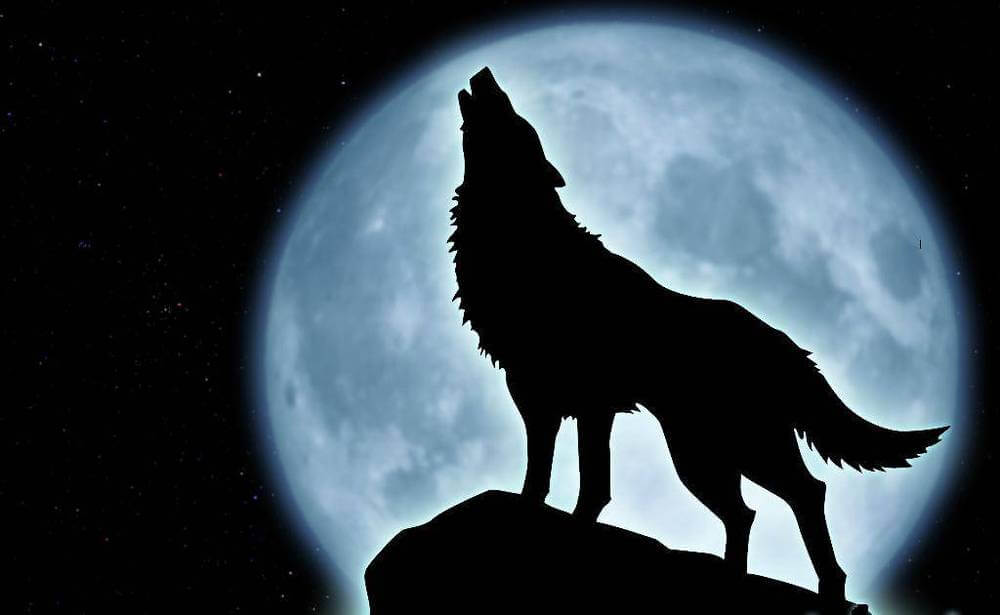
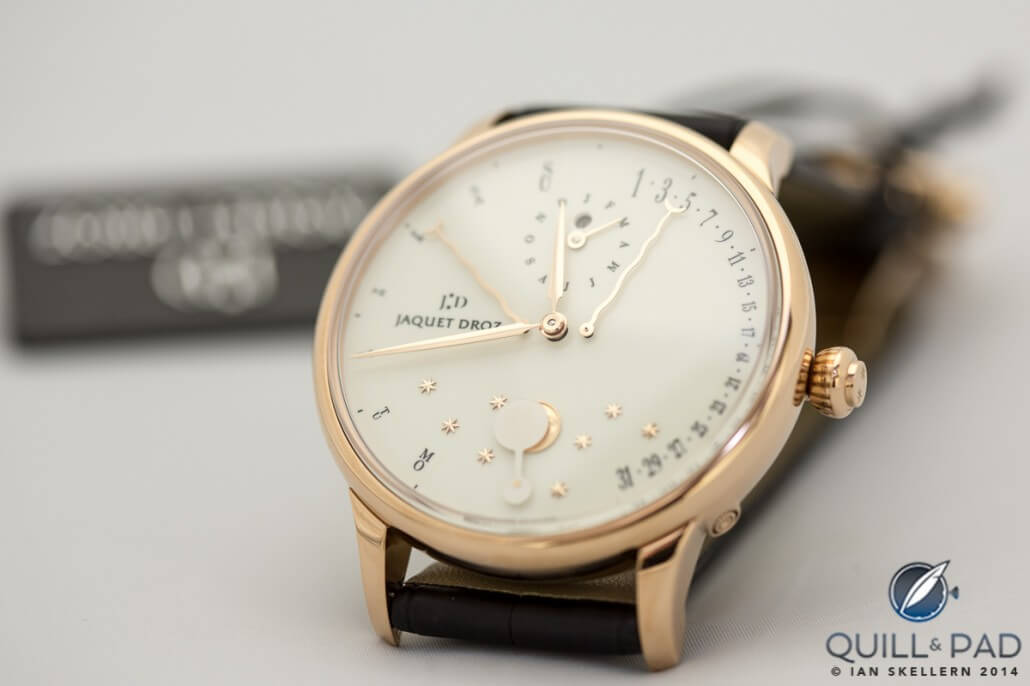

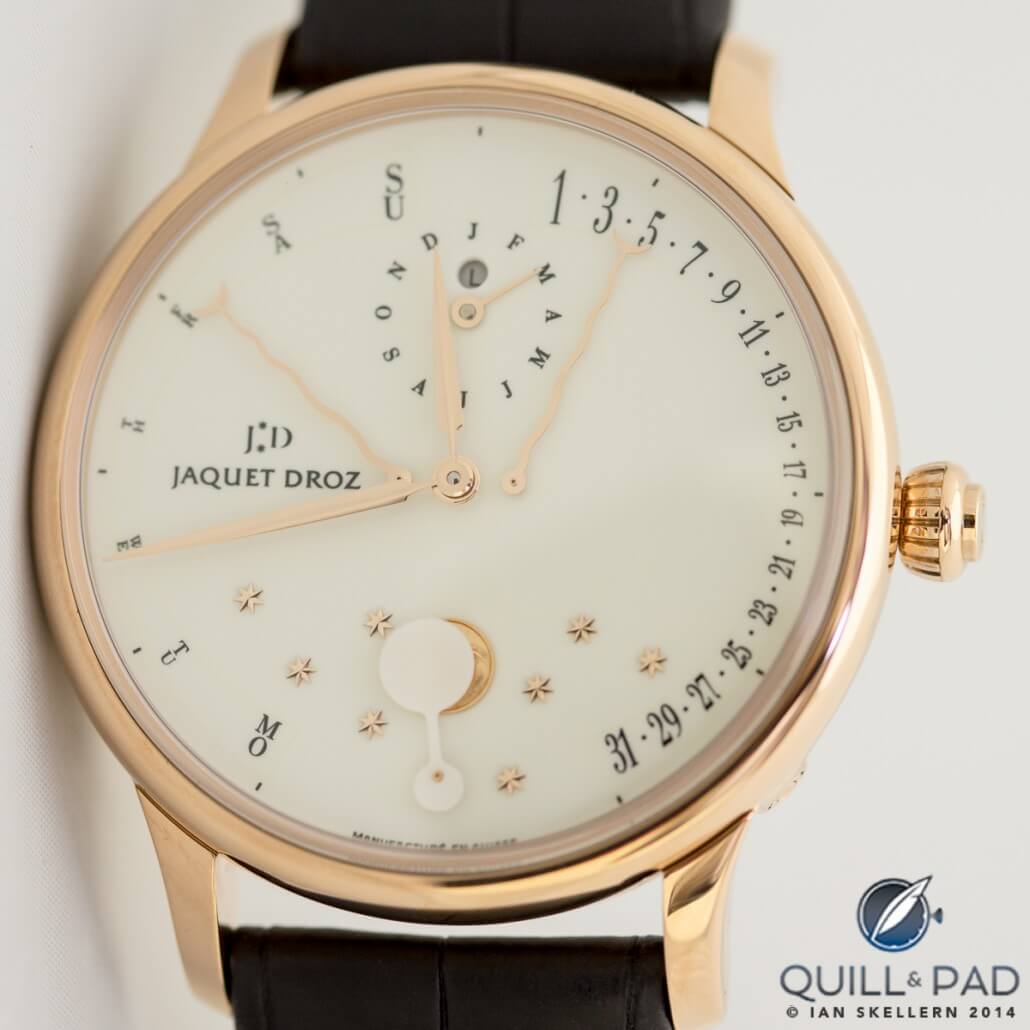
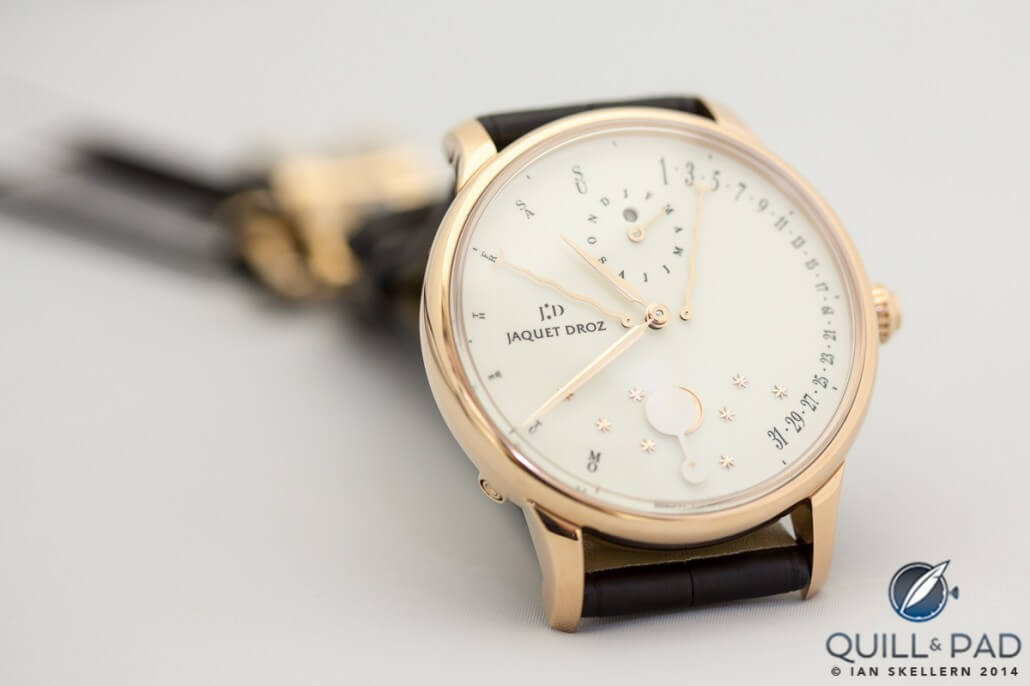
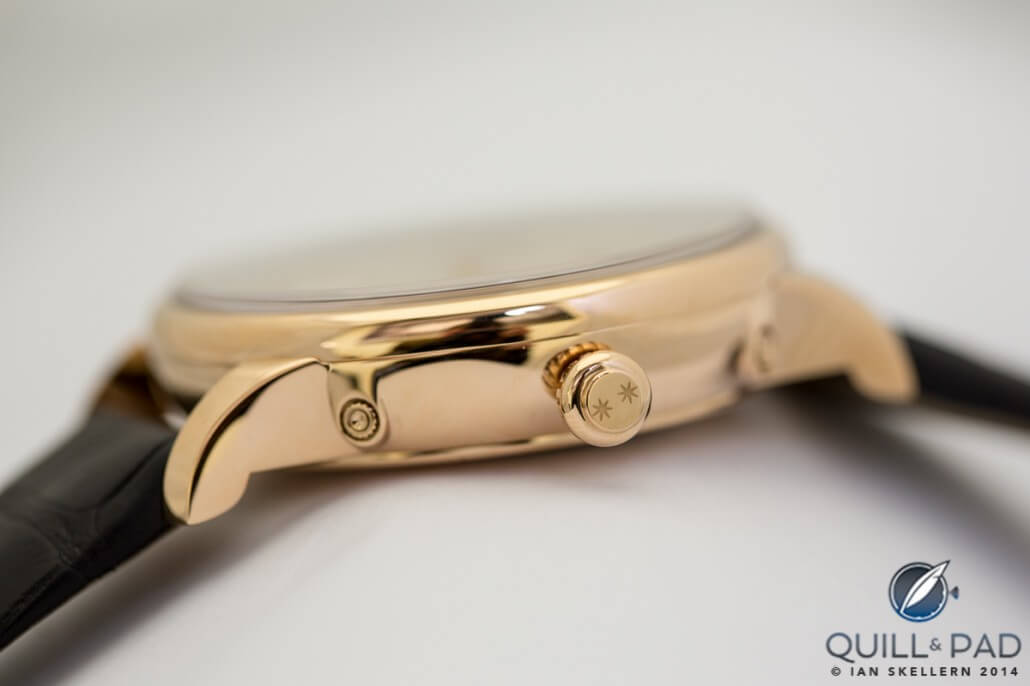

Trackbacks & Pingbacks
[…] See more about this brand’s breathtaking Éclipse perpetual calendar at The Moon Of Your Heart: Jaquet Droz Perpetual Calendar Éclipse. […]
Leave a Reply
Want to join the discussion?Feel free to contribute!